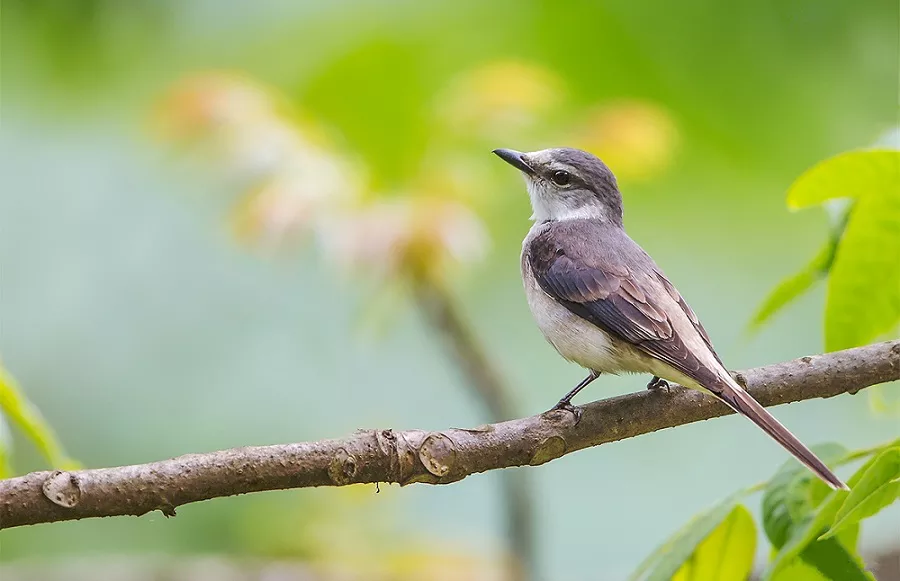The ashy minivet (Pericrocotus divaricatus) is a passerine bird of eastern Asia belonging to the minivet genus Pericrocotus in the cuckooshrike family Campephagidae.
What does ashy minivet look like?
The ashy minivet male has a white forehead and the front of the head. Nose feathers, forehead feathers at the base of the mouth, eyes first, back of the head, pillows, and ear feathers are bright black, and the entire upper body, including the nape, back, waist, and upper cover feathers of the tail, is slate gray. The inner coverts of the wings are the same color as the back, and the innermost secondary flight feathers are also the same color as the back with a gray-white narrow edge. The rest of the flight feathers are dark brown, with gray-white horizontal spots running through near the base of the feathers, forming an oblique band. Seen from below, it is in the shape of “∧”, which is very obvious. The two pairs of tail feathers in the center are dark brown, the base of the remaining tail feathers is black, and the tip is white. The underparts from the chin to the undertail coverts, including the neck side and the front part of the ear feathers are generally white, the chest side and two flanks are slightly off-white, the underwing coverts are white mixed with black spots, and the axillary feathers are black with white end spots.
The upper body of the female bird is almost pure gray, the forehead is grayish white, the nose feathers, a row of forehead feathers at the base of the beak and the eyes are dark brown first, from the top of the head to the back and shoulders, including the covert feathers on the inner wings are generally gray, and the two wings and the tail are also dark brown. It is lighter and dusty than the male bird, and the rest is the same as the male bird.
The iris is dark brown, and the beak, feet and claws are black.
Ashy minivet habitat
During the breeding season, it mainly inhabits dense primary deciduous broad-leaved forests and mixed Korean pine broad-leaved forests. During the non-breeding season, it also occurs in forest edge secondary forests, riparian forests, and even sparse forests and tall trees near courtyards and villages.
Ashy minivet living habit
Migration: The ashy minivet is mainly a summer migratory bird in Northeast China, and a traveling bird in other areas. They moved to the breeding grounds in Northeast China in early May in spring, and began to migrate southward in late September and early October in autumn, and a few of them stayed in the breeding grounds of Changbai Mountain as late as late October without migrating.
Habits: Flocks often fly above the tree canopy, singing while flying, and the sound is clear and crisp. When staying, they often live alone or in pairs on the top side branches or dead branches of large trees. Fly forward in waves. During the migration, there are sometimes large groups of dozens of birds, but most of them fly in a loose formation and sing while flying or disperse in the trees to move and prey, and often fly forward slowly. Sometimes it also rests on a few isolated trees that are rare in the village.
Diet: Mainly feed on insects and insect larvae such as click beetles, beetles, ladybugs, caterpillars, stinkbugs and other Coleoptera, Lepidoptera, Homoptera and other insects.
Distribution area of Ashy minivet
Distributed in China, Far East, Korea, Japan, Ryukyu Islands, Indochina Peninsula, Thailand, Myanmar, Philippines, Indonesia and Kalimantan.
Mode of reproduction
The breeding season is from May to July. It usually nests in deciduous broad-leaved forests and Korean pine broad-leaved mixed forests, and the nests are mostly placed on the side branches of tall trees. The nest is bowl-shaped and is mainly composed of dead grass, twigs, bark, moss, lichen and other materials. The height from the ground is 4-15 meters, and the nest is well concealed, surrounded by dense branches and leaves. The size of the nest is 7-8 cm in outer diameter, 6-7 cm in inner diameter, 4-6 cm high and 2-4 cm deep. Each clutch lays 4-5 eggs. The eggs are off-white or blue-gray, covered with dark brown or yellowish brown spots, the size of the eggs is 15-16 mm × 20-21 mm, and the egg weight is 2.5-3.5 grams.


 Facebook
Facebook  Instagram
Instagram  Youtube
Youtube 